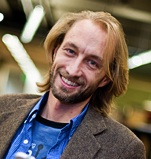Background
I’ve been insanely fortunate in my career. I started out working on virtual reality devices to train doctors on tricky medical procedures. From there, I went on to build supercomputers for the DoD and work on, well, rocket science. I then went to grad school and worked on both more numerical methods (real-time finite element analysis for augmented surgery and a bit of quantum electronics modeling). While working on my PhD (optimizing the R interpreter), I got the opportunity to create a new programming language and compiler for a research project at Oracle (the world’s fastest programmable NIC). Next thing I know, I’m at H2O.ai developing the most scalable open-source machine-learning library. After that, it was a weird ride through several startups heading up their machine-learning/ AI efforts. That meant helping the SEC hunt down illegal stock trades, helping to save nVidia millions in manufacturing costs, developing an algorithm that could get silicon layer deposition accurate to 1 Angstrom (the size of an atom), making systems that help lawyers track their work, building a Siri/Alex for doctors to dictate patient notes, and lots more. Eventually though, I wanted to return to research.
CAIRO
Together, Dr. Schilling and I founded the CAIRO lab at Dartmouth-Hitchcock Medical Center. Our goal is to focus on leveraging deep learning’s (DL) strength in solving natural language and computer vision problems to improve healthcare outcomes. In Orthopaedics, where medical imaging is such a critical tool, the opportunities for improvements abound. From automating common tasks to detecting indicators of disease too subtle for the human eye, there are countless applications.
With a finite number of healthcare providers, the automation of simple diagnoses lets the healthcare system do more with less. This is critical and makes up a significant portion of my focus. But augmenting diagnoses is only a part of the challenge. Equally important is knowing what solution will best address it. Many healthcare solutions come with great costs in terms of recovery effort and medical spending. In building tools to enable the automation of diagnoses, I am also creating the tools I need for medical discovery. Using retrospective data, DL allows me to discover subtle, pre-existing clues in medical images that can predict functional outcomes. This enables a provider to select the optimal solution and ensure we are giving the best care.
While the field has seen a boom of studies exploring these potentials, pure research merely showing viability is not enough. Through years of developing machine learning (ML) solutions in Silicon Valley, I know that clever algorithms are only half the solution. There is a real need for more translational ML research to move ideas from feasibility studies to measuring how these tools impact clinical outcomes. I seek to use my background to bridge this gap.
Finally, as machine learning researchers, we all rely on significant amounts of software developed by others. Not starting from scratch expedites our work and lets us answer the core questions we want to explore faster. I believe it is important to share the tools I built through my research. This allows others to contribute and expand upon my work. It simplifies the work of comparing techniques. It also lowers the barrier for others to advance existing ideas or explore new directions. A rising tide lifts all research, and it is incumbent on all researchers to contribute through sharing tools and not simply publishing.

